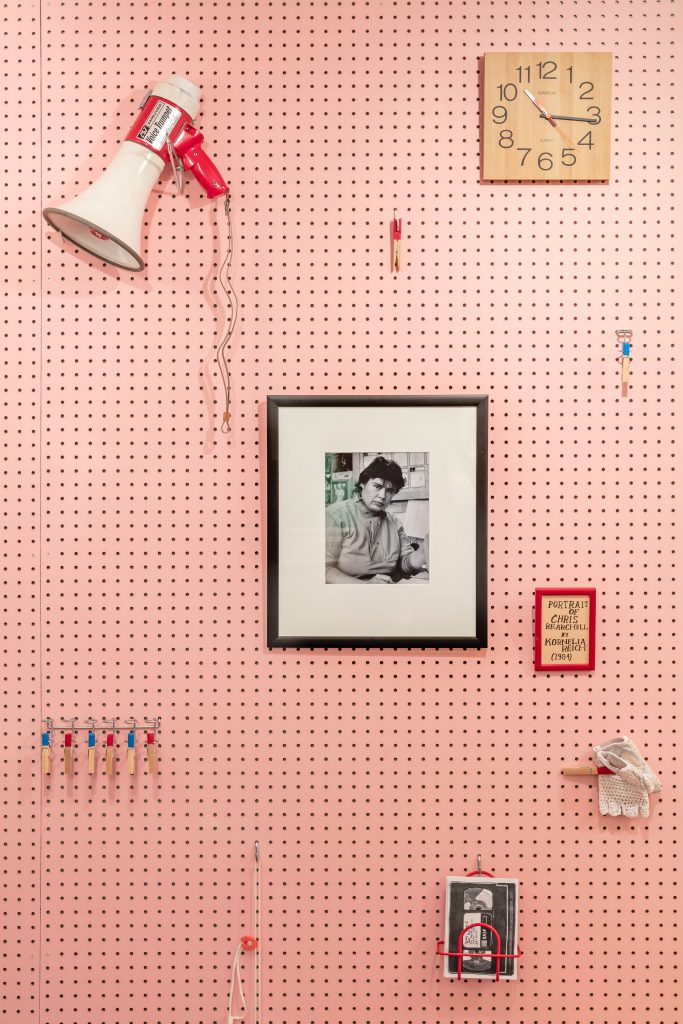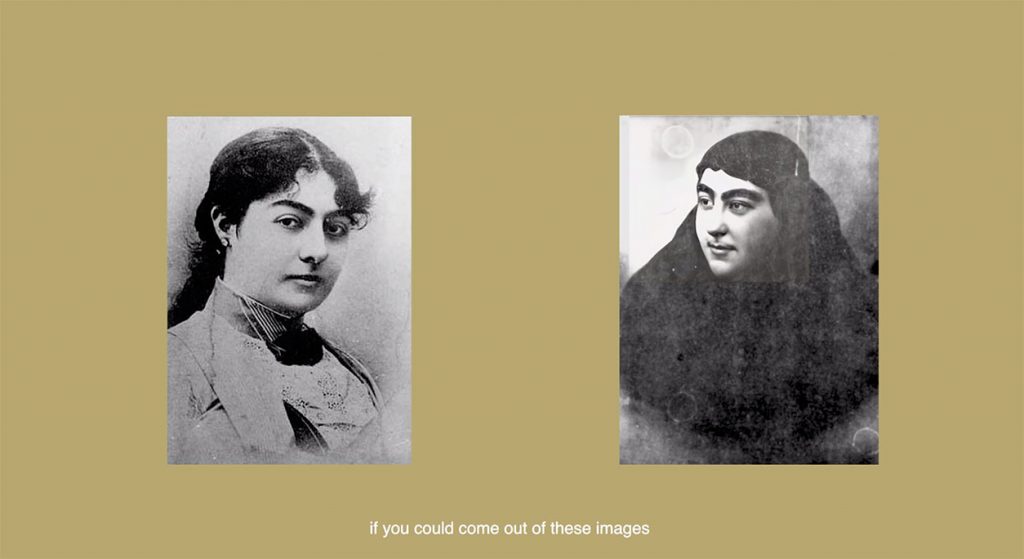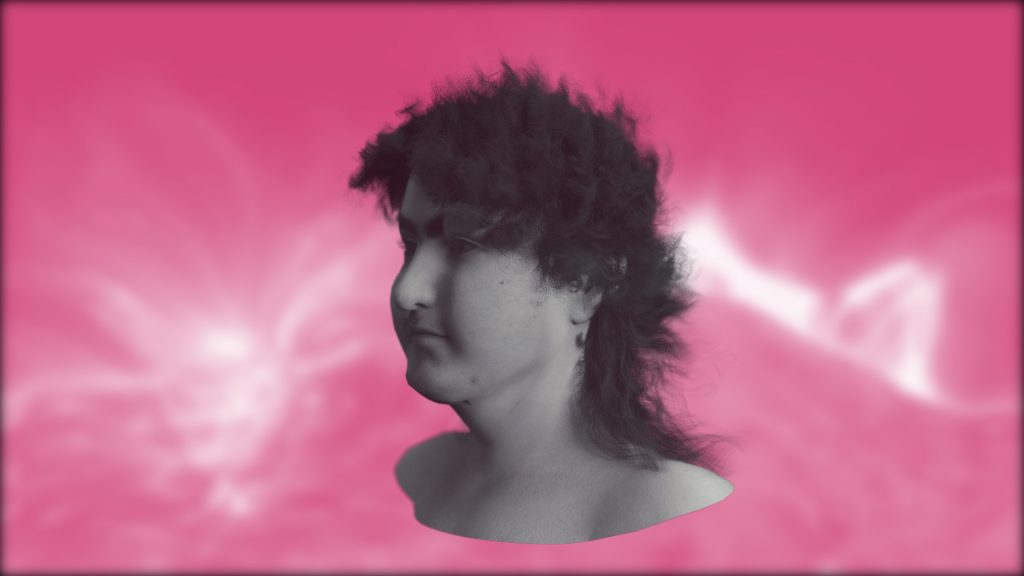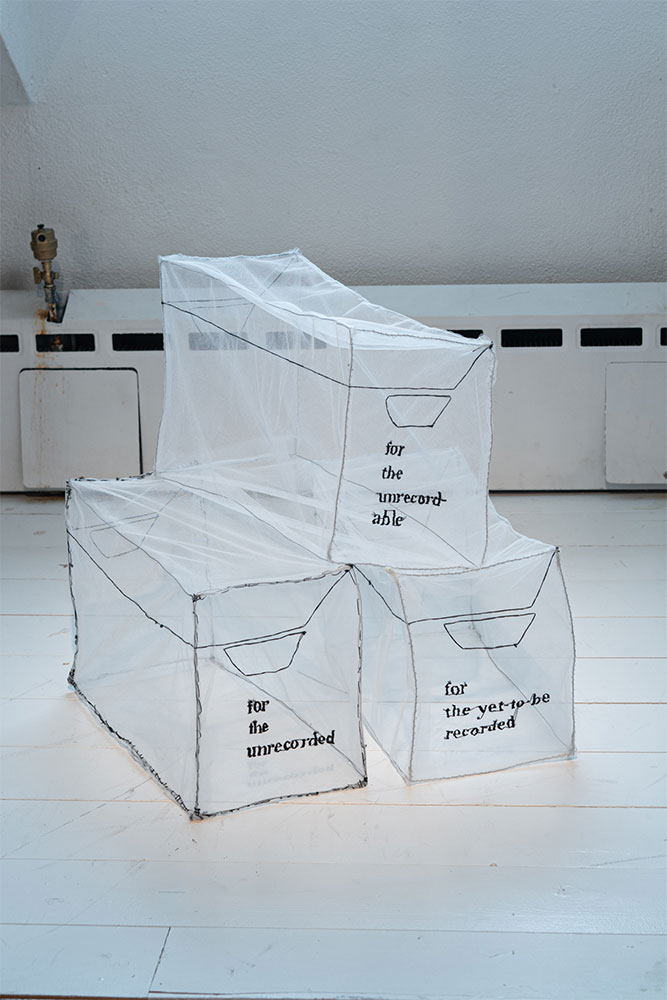Mnemonic silences, disappearing acts
By Dallas Fellini | August 2023
This is part of the Art Museum’s ongoing series of Virtual Spotlights centred on our collections, exhibitions, and projects. This Spotlight complements the exhibition Mnemonic silences, disappearing acts, on view at the Jackman Humanities Institute from September 13, 2023 to June 21, 2024. Curated by Dallas Fellini, the exhibition is presented by the Art Museum in conjunction with the Jackman Humanities Institute’s 2023–24 research theme Absence. Click here for details on how to visit the exhibition.
The archive has long been theorized as a structuring force that informs public memory, state narratives, and the making of official history. When trans and queer histories enter the archive, the conditions upon which they are absorbed are often those of surveillance, criminalization, coloniality, and degradation. More commonly, however, these histories do not make their way into official archives at all, which leads to a fragmented remembering of queer and trans pasts.
Mnemonic silences, disappearing acts grapples with the absences, erasures, and censorships that colour the queer and trans archive, seeking forms of documentation, storytelling, and memory-keeping that serve marginalized communities. Queer and trans histories are largely defined by archival silences, gaps in the historical record where documentation is absent or detrimentally distorted. What happens when the archive, ratified as the bona fide memory-keeper, forgets us? The artists in this exhibition draw out the unreliable qualities of stored memory, positioning their work in the spaces where the archive momentarily goes out of focus. Through fiction-making, critical imagining, and revisionism, they gesture at and supplement histories of queer and trans people that are insufficient, compromised, colonial, or simply absent.
A pink pegboard strewn with instruments for archiving and for play interrupts the administrative space of the Jackman Humanities Institute. Originally developed by Hazel Meyer and Cait McKinney for their 2016 exhibition at The ArQuives (formerly the Canadian Lesbian and Gay Archives), The Pink Pegboard from Tape Condition: degraded (2016) (2023) is reimagined here as a spatial intervention into the JHI’s lounge area, offering up a diverse assortment of tools to visitors. Rubbing alcohol, written instructions for VHS digitization, and other materials related to VHS preservation are interspersed with rubber-tipped clothespins, a wooden paddle, and a soldering iron, creating an imagined hybrid archive of BDSM and VHS archival practices. Objects like nitrile gloves traverse archival and kinky realms, bringing to mind the significance of porn as a record of queer history and, consequently, as an indispensable archival object. Meyer and McKinney’s installation speaks to the complexities of collecting queer porn: histories of anti-queer censorship and police violence permeate the queer kinky archive, while the failure to preserve analog video materials similarly acts as a force of erasure. What loss is present in a degraded VHS tape? In a bankers box confiscated by Toronto Police? Drawings of VHS tapes are indexed with handwritten titles that tease electrifying content: “Sticky Business,” “Canyon Water Works,” “Young + Hung II.” Meyer and McKinney’s imagined archive positions fiction-making as a response to censorship and absence, forwarding an archival practice that prioritizes the conservation of documents of queer desire.

In Kasra Jalilipour’s Gut Feelings (2021), archival desire and queer fiction-making are explored in two video works centred on Tāj al-Saltaneh (1884–1936), a feminist activist and member of the Qajar dynasty. One work is a video essay combining images of Tāj al-Saltaneh and other Qajar-era women with a narrative voice-over emulating the familiarity of a voicemail message left for a close friend. Jalilipour enacts queer fiction-making in order to confront a need to find queerness in an archive that actively disappears it, examining the role that erasure and manipulation play in archival constructions of truth. They interrupt pre-Westernized Iranian histories, emphasizing the often mis-remembered narrative of Tāj al-Saltaneh in order to insert a queerness that has been expunged.

Jalilipour’s exercise in speculation and longing employs a strategy that scholar Saidiya Hartman has termed critical fabulation: using combined methods of archival research and fiction-making in order to navigate histories that are unknowable or exist outside the limits of the archive.[i] Jalilipour grapples with devastating gaps through a decolonial and queer approach to history-making that refuses the oppressive archival methods of the past. A second moving image work completes their video essay: 3-D renderings of Tāj al-Saltaneh and the artist revolve and merge into each other, prompting considerations of the normative forces of the Western archive, forces that are in service of Eurocentricity, heteronormativity, and patriarchy. Gut Feelings interrogates these archival biases and digitally disseminated misinformation, asking us to consider whose stories are preserved, and for whom.

Kama La Mackerel uses self-documentation as revisionism to interrogate the aesthetics of tourism-oriented island postcards and what they represent within the colonial visual archive. Their photo series Breaking the Promise of Tropical Emptiness: Trans Subjectivity in the Postcard (2019) interrupts the romanticized imagery of their home island, Mauritius. In these photographs, the artist inserts their own trans body into the foreground of postcards, print media which have traditionally represented islands as terra nullius. Framing themself amidst sugar cane fields and picturesque greens and blues, La Mackerel responds to a history of deletion of Mauritian citizens from the colonial archive and questions how postcards exoticize island spaces. The exclusion of Mauritian citizens from postcards further mirrors the silencing and repression of gender and sexually diverse Mauritians that occurred under colonial rule and persists in the country today. Addressing this erasure by drawing from gender diverse Mauritian histories, La Mackerel creates a trans counter-archive that disrupts an invisibilizing colonial imaginary.

Jordan King similarly turns to revision, remix, and insertion in her engagements with the trans archive. In Untitled (2020), King presents a series of four self-portraits. She poses in a drab New York apartment, costumed in glittering cabaret wear animated by the flash of a Polaroid camera. King documents herself as part of a long and under-recorded history of trans women and transfeminine drag performers. In responding to this history, she looks to the figure of International Chrysis, a legendary drag and cabaret performer best known for her presence in New York nightlife in the 1980s. Presented alongside King’s self-portraits are personal photographs of Chrysis that King inherited. King’s self-portraits respond to and restage these photographs, emphasizing the experiences and positionalities that the two women share: both performing in the New York cabaret scene as trans women, and both—by incredible and serendipitous coincidence—inhabiting the same run-down apartment three decades apart.
The queer, non-traditional provenance of International Chrysis’s archive is not uncommon for trans people; documentation of trans lives is rarely incorporated formally into official archives, being passed instead from friend to lover to community member and preserved through a web of queer relationships. King’s project speaks to the non-institutional systems through which trans histories are remembered, forging a cross-generational, posthumous relationality in her restaging of Chrysis’s Polaroids. Across both King’s and Chrysis’s photographs, the apartment is animated as a space that hosts a spectral trans presence. Its haunted quality offers an alternative to the overwhelming void left by trans histories that have gone unrecorded and trans ancestors who have been lost: King turns to embodied historical inheritance in the face of institutional archival failure.

Translucent, hand-embroidered textiles from Lan “Florence” Yee’s series PROOF (2022–2023) are cast around the Jackman Humanities Institute. They hang from the ceiling and nestle into window frames. These works wrestle with a desire to see histories of queer and trans people of colour reflected in the archive and the simultaneous problematics of becoming possessed by a space that has historically been inhospitable for queer people of colour. Photographs of places and objects with ambiguous relationships to identity are embroidered with the word PROOF, calling into question what constitutes a specifically queer or trans image. Yee criticizes how images are often reduced to evidence of queer and trans people’s historical existence in order to argue for queer and trans humanity. They ask what other forms of remembering might serve marginalized communities, outside of the authoritarian confines of the white and cis-hetero-patriarchal archive.[ii]
Accompanying these hanging textile works is Leaving Space (2019), a series of three filing boxes constructed out of tulle and steel wire. Embroidered labels on the front of these boxes read “for the unrecorded,” “for the yet to be recorded,” and “for the unrecordable.” Yee speaks to the slippery and ephemeral nature of queerness, responding to theorist Jack Halberstam’s argument that failure and forgetting are productive alternatives to the flattening nature of cis-hetero-patriarchal archival memory.[iii] In questioning racialized and queer people’s yearning for archival inclusion, Yee offers a reminder of the archive’s violence, of its function as surveillant and punitive. Perhaps there is a generative quality in the voids and absences that disproportionately populate the queer and trans archive. Perhaps we learn to find solace in being unrecordable.

There is much to say about what we lose when we disappear, but what can be born out of the resulting empty space, out of the moments when we don’t exist? Kasra Jalilipour, Jordan King, Kama La Mackerel, Hazel Meyer and Cait McKinney, and Lan “Florence” Yee respond to the mnemonic absences that haunt the trans and queer archive, speculating on the historic record and exploring new strategies for transforming relationships with archival silences. The archive’s failure to remember is transformed and potentiated through intertemporal relationships between queer past and queer present. A consuming impulse to fill a hole is acted on, but simultaneously refused in moments when we see the void swell and swallow itself: a falsified narrative, a deteriorating Polaroid, an empty bankers box.
Endnotes
[i] Saidiya Hartman, “Venus in Two Acts,” Small Axe 12, no. 2 (2008): 11.
[ii] See bell hooks’s writing on imperialist white supremacist capitalist patriarchy. bell hooks, Writing Beyond Race: Living Theory and Practice (New York: Routledge, 2013), 4.
[iii] Jack Halberstam, The Queer Art of Failure (Durham, North Carolina: Duke University Press, 2011).
Credits
Banner Image: Kasra Jalilipour, Gut Feelings: Fragments of Fiction, 2021. Video, 3:04. Photo courtesy of the artist.
Image 1: Hazel Meyer and Cait McKinney, Tape Condition: degraded, 2016. Mixed-media installation on pegboard, dimensions variable. Installed at the ArQuives: Canada’s LGBTQ2+ Archives. Photo by Toni Hafkenscheid.
Image 2: Kasra Jalilipour, Gut Feelings: Fragments of Truth, 2021. Video, 12:16. Photo courtesy of the artist.
Image 3: Kasra Jalilipour, Gut Feelings: Fragments of Fiction, 2021. Video, 3:04. Photo courtesy of the artist.
Image 4: Kama La Mackerel, Breaking the Promise of Tropical Emptiness: Trans Subjectivity in the Postcard, 2019. Inkjet on silk paper, 16 x 24″. Photo courtesy of the artist.
Image 5: Jordan King, Untitled, 2020. Polaroid, 3.5″ x 4.5″. Photo courtesy of the artist.
Image 6: Lan “Florence” Yee, Leaving Space, 2019. Hand-embroidered nylon thread, tulle, and galvanized steel wire, 10″ x 7.5″ x 15″, set of three boxes. Photo by Alexis Bellavance.
Essay text by Dallas Fellini. Edited by Hana Nikčević.
About
Dallas Fellini is a curator, writer, and artist living and working in Toronto. They are a member of Crocus Collective and a co-founder of Silverfish, an arts publication devoted to interdisciplinary collaboration, skill-sharing, non-institutional pedagogy, and cultivating sustained dialogue between contemporary artists and writers. Fellini is pursuing a Master of Visual Studies in Curatorial Studies at the University of Toronto. Their curatorial research is situated at the intersection of trans studies and archival studies. (dallasfellini.com)
